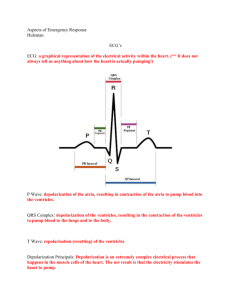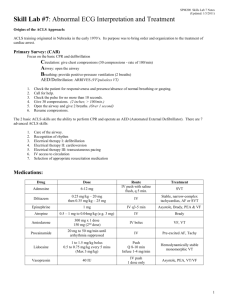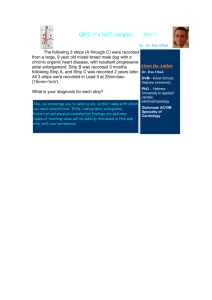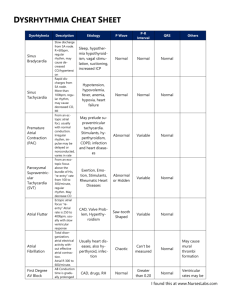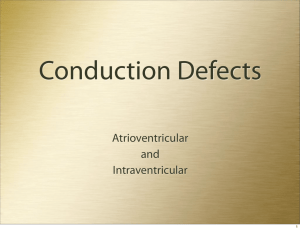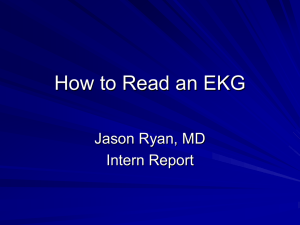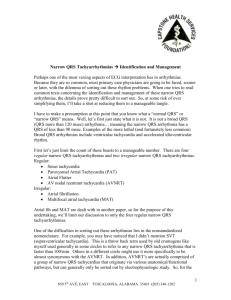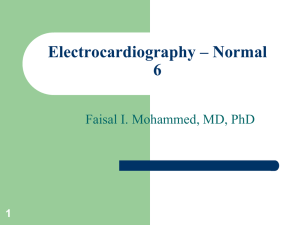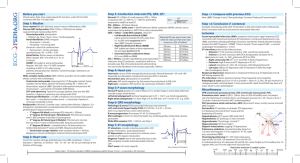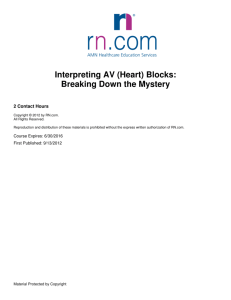Cardiology Flash Cards
advertisement
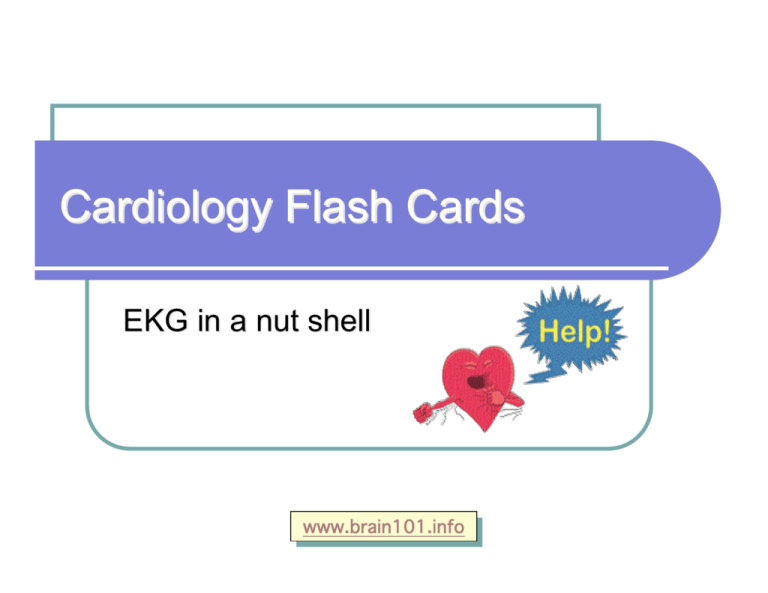
Cardiology Flash Cards
EKG in a nut shell
www.brain101.info
www.brain101.info
Conduction System
www.brain101.info
2
Analyzing EKG
Step by step
Steps in Analyzing ECG'S
1. Rhythm:
- Regular _ “Sinus, Junctional or Ventricular”.
- Irregular _ “Regular irregularity, or irregular
irregularity”
2. Rate:
- Normal _ (60-100 BPM)
- Bradycardia _ ( less than 50)
- Tachycardia _ ( More than 100)
www.brain101.info
4
Steps in Analyzing ECG'S
3. P-Wave:
- normally “well rounded, followed by QRS.
- +ve in leads “I, II, V4 & V6”, -ve in “avF”
- Biphasic in “V1”.
- Should not exceed 2-3 mm.
- Its duration “.11 sec”
- Abnormality: “Notched, wide, _ amplitude”
- Best lead to evaluate is “II”.
www.brain101.info
5
Steps in Analyzing ECG'S
4. PR-interval:
- Normally: “Isoelectric” (0.12-0.20 sec)
- Abnormality:
a. Short _ WPW “Delta Wave”
b. Prolonged _ 1° AV block
www.brain101.info
6
Steps in Analyzing ECG'S
5. QRS complex:
i. Duration _ “0.06-0.10” sec. [2 boxes]
ii. Amplitude _ standard LL > 5 mm
_ CL V1, V6 = 5 mm
_ CL V2 V5 = 7 mm
_ CL V3 V4 = 9 mm
iii. Timing of intrinsicoid deflection “the length of
time that allow the impluse to travel from endo ->
epicardium.
iv. R-wave progression in the chest leads.
www.brain101.info
7
Analysis of Rhythm
!
Prolongation over 0.2 seconds suggests a delay in the conduction
system between the SA node and the AV node indicating a first
degree heart block. When it takes two or three P-waves to initiate
a QRS complex this is termed a 2:1 or 3:1 type second degree
heart block. When the P-R interval becomes progressively longer
until a QRS complex is dropped and then the process repeats,
this is called a Wenckebach phenomenon, (a type of second
degree Mobitz I block). If the QRS complex is periodically blocked
without lengthening of the P-R interval this is called a Mobitz II
block.
!
A third degree block exists when the P and the QRS waves are
entirely disassociated. These blocks often result from interference
along some part of the His-Purkinje system which can usually be
located by examining the chest leads such as Vl-V6 to determine
if it is a right or left bundle branch block as well as its type.
www.brain101.info
8
www.brain101.info
9
EKG Axis in a Glance
!
Using leads I and aVF the axis can be
calculated to within one of the four quadrants
at a glance.
!
If the axis is in the "left" quadrant take your
second glance at lead II.
www.brain101.info
10
AXIS IN A GLANCE
! both
I and aVF +ve = normal axis
! both I and aVF -ve = axis in the
Northwest Territory
! lead I -ve and aVF +ve = right axis
deviation
! lead I +ve and aVF -ve
lead II +ve = normal axis
! lead II -ve = left axis deviation
!
www.brain101.info
11
Criteria of 1º A-V Block
!
Prolongation of A-V conduction time (P-R)
interval to 0.21 or more.
!
P-R interval usually represents delay in the
AVN, but at times it may reflect delays either
above “Intra-atrial” or below “HIS – Purkinje”
the node
www.brain101.info
12
First degree AV block can be due to:
! Inferior
MI,
! Digitalis toxicity
! Hyperkalemia
! Increased vagal tone
! Acute rheumatic fever
! Myocarditis.
www.brain101.info
13
2º A-V Block
When some of the atrial impulses fail to
reach the ventricle because of impaired
caonduction.
! Types:
!
"
"
Type I “Wenckeback”
Type II “Mobitz”
www.brain101.info
14
Type I “Mobitz I” “Wenckebach”
!
!
Prolonged P-R interval prior the drop {P} wave
Associated with:
"
"
"
!
Rheumatic HD
Acute inferior MI
Digitalis or Propranolol effect.
Chronic 2º type (I) associated with:
"
"
"
"
"
Chronic Ischemic HD
Aortic Valve disease.
Mitral Valve Prolapse.
ASD “Atrial Septal Defect”
Amyloidosis.
www.brain101.info
15
Type I “Mobitz I” “Wenckebach”
! Second
degree AV block type I occurs in
the AV node above the Bundle of His.
! Treatment is usually not indicated as this
rhythm usually produces no symptoms
www.brain101.info
16
Type II “Mobitz II”
! Its
is usually associated with constant
prolonged PR interval followed by one P
wave is not conducted to the ventricles.
! QRS usually widened because this is
usually associated with a bundle branch
block.
! This block usually occurs below the
Bundle of His and may progress into a
higher degree block.
www.brain101.info
17
Type II “Mobitz II”
" It can occur after an acute anterior MI due to damage
in the bifurcation or the bundle branches.
" It is more serious than the type I block.
" Treatment is usually artificial pacing.
www.brain101.info
18
Third Degree Heart Blocks (Complete
AV Dissociation)
"
"
"
"
Third degree blocks are characterized by a complete AV nodal
block resulting in no depolarization of the ventricles (i.e. no
ventricular contraction takes place).
The electrical signal from the SA node is blocked between the
atria and ventricles of the heart. This conduction dysfunction
generally occurs between the AV junction and the bundle of His.
Therefore, the ventricles must create their own impulse in order
for contraction to occur. Both the atria and ventricles function
as two separate units each with its own rate (atria, 60 bpm and
ventricles, 20-40 bpm).
This is a lethal dysrhythmia due to the fact that it can evolve
into ventricular standstill or asystole. Since the independent
firing rate of the ventricles is 20-40 bpm, perfusion of the entire
system will not be adequate enough to sustain life. Causes of
third degree heart block include Digitalis toxicity, MI and
massive heart disease. Patients with third degree heart block
usually need a pacemaker.
www.brain101.info
19
Hemi-Block
Anterior Hemi-Block
1. LAD (-60º)
2. Small Q Lead (I)
Small R Lead (III)
Deep S Lead (III)
3. Normal QRS
4. Delayed internsicoid
in aVL
Posterior Hemi-Block
1. RAD (+120º)
2. Small R Lead (I)
Small S Lead (III)
Small Q Lead (III)
3. Normal QRS
4. No evidence of RVH
www.brain101.info
20
HINTS:
LEAD
LI
L aVL
L II
L III
L aVF
Anterior
AHB
+
+
-
-
-
Posterior
PHB
-
-
+
+
+
www.brain101.info
21
Bundle Branch Block
LBBB
V1 QS or rS
RBBB
V1 late intrinscoid, M
shaped QRS (RSR’)
sometimes wide (R)
V6 Early intrinscoid,
wide (S) wave
L1 Wide (S) wave
V6 Late intrinscoid &
No (Q) wave
L1 Morophasic ® wave,
No (Q) wave
In Both (QRS) is 0.12 Secs. Or more
www.brain101.info
22
Incomplete Bundle Branch Block
!
Same criteria for LBBB & RBBB, But the QRS
is (0.09 – 0.11) Secs
www.brain101.info
23
Intraventricular Conduction Defect
“Delay” (IVCD)
! Wide
QRS > 0.10 Secs
A lesion in the ventricular conduction,
slower spread of activation through out the
ventricle.
! “Always check (P) wave & (PR) preceeding
each abnormal QRS, to differentiate
between Supraventricular & Ventricular
rhythm.
!
! Prolonged
QT Interval
www.brain101.info
24
Atrial premature Beats (APB)
Ectopic focus discharges an early
impulse other than SAN
! Criteria:
!
1.
2.
3.
4.
Premature (early).
Different looking (P) wave.
Followed by long internal but not a fully
compensatory pause.
Can result in drop (P), with Nonconducting APB
www.brain101.info
25
Prematura Atrial Contraction (PAC)
www.brain101.info
26
Premature ventricular Beat
!
!
!
!
!
Timing -» early (Premature)
(P) wave -» absent, or retrograde.
QRS -» wide & Bizarre
Compensatory pause following QRS.
Types:
1. (R on T) malignant VPC -» Very early
2. Interpolated VPC -» doesn’t interrupt the normal
rhythm manner, sandwiched between (2) sinus
beat.
3. End diastolic -» shortened PR interval & there is no
relation between P & QRS
www.brain101.info
27
PVCs {CONT.}
! Another
classification for VPCs:
Unifocal -» Look alike.
! Multifocal -» Looks different.
!
! Timing
of occurance:
Bigiminy (2 PVCs) Couplet.
! Trigiminy (3 PVCs) Triplets
! Quadgiminy (short run of VT)
!
www.brain101.info
28
Abnormal Heart Rhythm
Cardiac Arrhythmia
Paroxysmal atrial tachycardia (PAT)
! Rate:
150-250 / Min
! QRS: Normal in configuration.
! P wave: not visible.
! After accompanied by non-specific ST-T
wave changes.
www.brain101.info
30
Multifocal “Chaotic” atrial rhythm
! Caused
by rapid firing of two or more
ectopic atrial focus.
! Rate:100-200 / Min
! (P) waves are different in configuration.
! (PR) intervals varies from one beat to
another.
! (QRS) is normal.
www.brain101.info
31
Atrial Tachycardia
www.brain101.info
32
Atrial Flutter
!
Atrial flutter is usually associated with mitral valve disease,
pulmonary embolism, thoracic surgery, hypoxia, electrolyte
disturbances and hypercalcaemia. Atrial flutter results in poor
atrial pumping since some parts of the atria are relaxing while
other parts are contracting. Cardiac output decreases
because the ventricles do sufficiently fill (as they would
normally) before ventricular contraction. Ablation of some of
the heart tissue to stop impulses from travelling around can
be used to treat this condition
www.brain101.info
33
Atrial Flutter
!
!
!
Atrial flutter occurs when the
atria are stimulated to
contract at 200-350 beats per
minute
The atrial flutter waves,
known as F waves, F waves
are larger than normal P
waves and they have a sawtoothed waveform. Not every
atrial flutter wave results in a
QRS complex (ventricular
depolarization) because the
AV node acts as a filter.
A whole number fixed ratio of
flutter waves to QRS
complexes can be observed,
for instance 2:1, 3:1 or 4:1.
www.brain101.info
34
Atrial Fibrillation
!
!
!
!
Multifocal (F) waves
replacing (P) wave
either coarse or fine.
Rate (350-650) BPM
Irregularly irregular
ventricular response.
QRS resembles
QRS of dominant
rhythm.
www.brain101.info
35
AV Nodal Re-entry Tachycardia
Abnormal circular conduction in the
AV Node.
www.brain101.info
36
WPW “Accessory Pathway”
!
An extra connection
(accessory pathway) is
present between the
upper chamber (atrium)
and lower chamber
(ventricle). Patients with
such a connection are
said to have the WolffParkinson-White
syndrome (WPW). The
extra connection is
shown here during
normal sinus rhythm.
www.brain101.info
37
WPW-Orthodromic Reciprocating
Tachycardia-Common
Here, the extra connection
is seen being used to
complete a circuit which
causes the tachycardia.
The electrical impulse
flows down the normal
AV node from the atrium
to the ventricle, then
returns back to the
atrium via the accessory
pathway, which acts as
a "short circuit" to
perpetuate the
arrhythmia.
www.brain101.info
38
Ventricular Tachycardia
www.brain101.info
39
Ventricular Fibrillation
!
!
Ventricular fibrillation
occurs when parts of the
ventricles depolarize
repeatedly in an erratic,
uncoordinated manner.
The EKG in ventricular
fibrillation shows random,
apparently unrelated
waves. Usually, there is
no recognizable QRS
complex
www.brain101.info
40
Atrial enlargment
!
!
!
!
!
P-Pulmonale -» narrow, pointd (P) wave in
limb & Rt. Chest leads.
P-Tricuspidale -» tall & notched with 1st peak
taller then 2nd.
RAE: small QRS voltage in V1 with abrupt
increase (x3) in QRS voltage in V2.
LAE: P wave widened to 0.12 sec, notched (P)
wave in limb leads + (-ve) terminal widened &
deeper (P terminal force).
P-Mitrale -» terminal (P) in V1, L3, aVF. _
duration > 0.04 sec.
www.brain101.info
41
www.brain101.info
42
www.brain101.info
43
PRACTICE Makes Perfect
Normal EKG
www.brain101.info
45
1st Degree AV Block
www.brain101.info
46
Complete Heart Block
www.brain101.info
47
Inferior MI, Sinus Bradycardia
www.brain101.info
48
Sinus Tachycardia
www.brain101.info
49
Atrial Premature Beat
www.brain101.info
50
Atrial Fibrillation with ??
www.brain101.info
51
Should we call a code!?
www.brain101.info
52
Atrial flutter with reentry circuit
www.brain101.info
53
Important Mimikar
www.brain101.info
54
PVC & Long QT
www.brain101.info
55
VT with clear dissociation
www.brain101.info
56
What is that?
www.brain101.info
57
Acute Inferior MI
www.brain101.info
58
Acute Anterior MI
www.brain101.info
59
Old Inferior MI
www.brain101.info
60
Acute MI with LBBB
www.brain101.info
61
RBBB, What else!
www.brain101.info
62

